A licence with an unlimited number of elements is required to run simulations or mesh a 2D zone or Mesh zone with Subgrid Sampling.

This is a Tech Preview of Subgrid Sampling.
In a traditional 2D model, topographic representation is normally improved by refining the mesh resolution, for example, by changing the size of the maximum triangle area for a 2D zone or a mesh zone or using terrain-sensitive meshing. As the mesh resolution is refined, the spatial discretization error is reduced and the numerical solution of the Shallow Water Equations (SWE) converges towards the expected result. However, refining the mesh may cause performance degradation in order to reach the desired model accuracy.
Subgrid Sampling has been included in ICM to enhance its predictive ability by introducing high resolution topographic representation into InfoWorks 2D models without compromising performance speed or result accuracy.
Conventionally, the 2D elements that are used to discretize the spatial domain and solve the SWE are considered flat surfaces. In other words, there is a single ground elevation for each 2D element, regardless of the underlying topography. Therefore, the topography becomes a series of stepped 2D elements, with the ground level for each 2D element calculated as an average value derived from the underlying ground model.
- Using volume/level tables to represent the storage in each 2D element.
- Refining topographic representation of the 2D element interfaces.
The 2D elements are divided into subgrid triangles and the ground level of each triangle is sampled from the ground model. A volume/level table is created to represent the storage capacity of the 2D element based on the sampled ground levels and area of each triangle. The interfaces between subgrid 2D elements are also divided as part of the triangulation process. The ground level of each subgrid face is also sampled and averaged from the ground model. These composite interface profiles are solved step-wise to obtain a compound mass and momentum flux, which results in a highly accurate representation of topographic barriers between 2D elements.
An example of how a subgrid 2D element is represented in the software is shown in Figure 1 while Figure 2 shows the GeoPlan view of a subgrid 2D element, subgrid 2D face, subgrid triangle and 2D face.
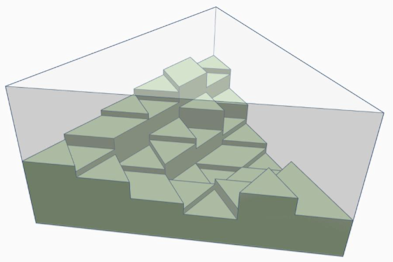
Figure 1 - 3D view of a subgrid 2D element with its inner subgrid triangles
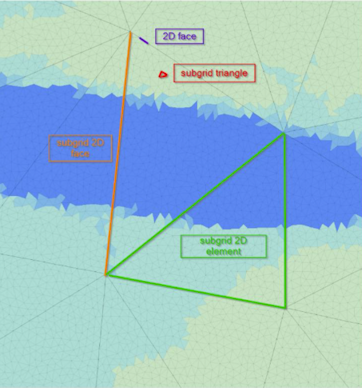
Figure 2 - GeoPlan view of a subgrid 2D element, subgrid 2D face, subgrid triangle and 2D face
Although the Subgrid Sampling method increases a simulation's overhead, as volume/level tables need to be created and checked and more interface calculations are required, it improves topographic representation, allowing the use of coarser 2D meshes to achieve the same accuracy as refined conventional meshes, but with significantly lower computational cost and storage requirements. Tests have shown speed increases of up to 2 orders of magnitude without compromising a model's accuracy, which should be considered a very favourable gain for most applications.
The impact of using Subgrid Sampling to enhance the topographic representation of flow in a channel is shown in Figure 3. The images at the top show the results on a channel for several mesh resolutions using the standard 2D engine. The quality of the results degrade significantly as the mesh resolution coarsens. The bottom show the results obtained using the Subgrid Sampling method in the same channel. The quality of the results after coarsening the mesh resolution is not affected and the engine performance is significantly improved.
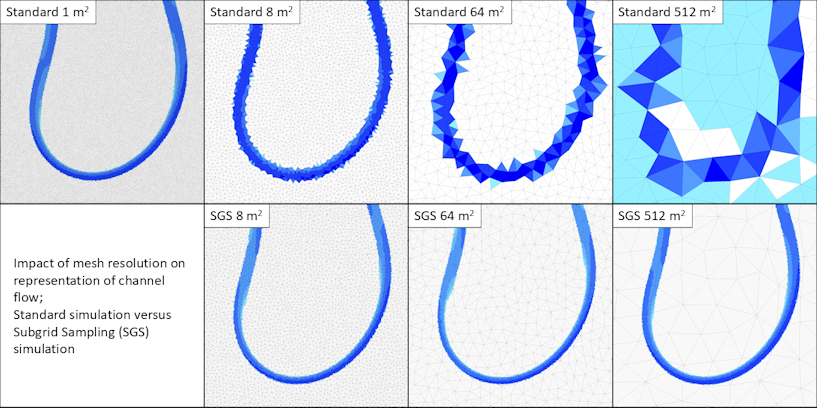
Figure 3 - Impact of Subgrid Sampling
Volume/level tables
Storage capacity for subgrid 2D elements is described by volume/level tables that are generated from the ground levels of the subgrid triangles in each 2D element. The ground level for each subgrid triangle is calculated from the average of multiple sampling points from the underlying ground model. The number of sampling points is a function of the ratio between the subgrid triangle area and the local ground model resolution. The subgrid triangle is recursively split in sub-triangles, and the ground level is sampled at the centre of each sub-triangle, with a maximum of 64 sampling points. The sampling points are all internal to the subgrid triangle; there are no sampling point in the boundaries.
Initial entries in the tables, whose aggregated area is below the specified subgrid triangle size, are removed. This filtering process reduces the presence of sudden level changes for small volumes under wetting and drying scenarios. This improves the numerical stability and performance of the 2D solver.
Figure 4 shows the normalised volume/level tables for 50 subgrid 2D elements. Each line in the graph represents the normalised volume level table for a single subgrid 2D element. The volume is normalised between 0 and the maximum volume in the table, and the depth is normalised between 0 and the maximum depth in the table. As opposed to the standard 2D solver, in which each 2D element is represented by a flat surface and the volume level relation is described by a linear relationship, in a subgrid 2D element the volume/level relationship is represented by a discretized curve. The 2D solver performs linear interpolations look ups in the volume/level tables to estimate water levels at subgrid 2D elements.
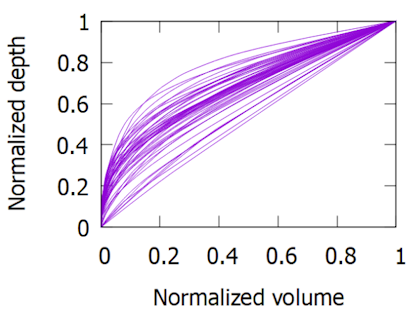
Figure 4 - Normalised volume/level tables
The volume/level tables can be simplified, if required, according to the depth tolerance properties specified in the Subgrid Sampling section of the simulation parameters. See Subgrid Sampling Time Step and Depth Tolerances for further information. By default no tolerances are set as volume/level table simplification has minimal impact on ICM's performance.
Flow representation
The ground level of the 2D faces in the model is also considered by the Subgrid Sampling method. This means that flow representation along a subgrid 2D face is more accurate than in the standard solver. The face flux calculation for each subgrid 2D face is compounded from the sum of multiple 2D face flux calculations.
Subgrid 2D face ground levels are calculated as an average of sampling points along the face. As in the subgrid triangle ground level sampling, the number of sampling points is a function of the subgrid triangle size and the ground model. The minimum number of subgrid sampling points for each of the 2D faces in a subgrid 2D face is 2 points, coincident with subgrid triangle vertices. The maximum number of sampling points is 9, which correspond to the sub triangles vertices generated in the recursive subdivision of subgrid triangles. These subgrid 2D face ground levels are included in the model to represent topographic barriers, as opposed to the standard 2D solver where the topography is defined by the element ground levels. An example of a subgrid 2D face is shown in Figure 5, where each step corresponds to a 2D face, whose ground level is sampled from the ground model using a minimum of 2 and a maximum of 9 points as described previously.
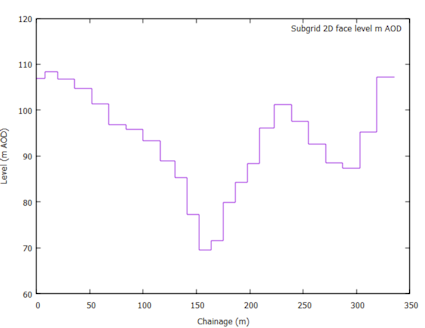
Figure 5 - Cross-section view of a Subgrid 2D face
Friction
The friction term calculation for Subgrid Sampling is based on the Manning's equation and an average depth of the subgrid 2D elements within a triangle. This method has been compared to other friction methods and produces accurate results without requiring look-up tables.
Time step estimation
There are several methods for estimating the time step at subgrid 2D elements, which can be specified in the Subgrid Sampling section of the simulation parameters. See Subgrid Sampling Time Step and Depth Tolerances for further information.
Subgrid sampling limitations
Blockage effects
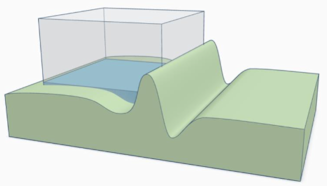
Figure 6 - Subgrid 2D element: Boundary aligned with a topographic barrier
Artificial tunnelling or leakage effects may appear on the model if the topographic barriers are not aligned with the mesh. Figure 7 shows an example of this scenario; water can cross the topographic barrier and artificial tunnelling or leakage occurs.
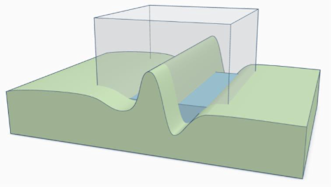
Figure 7 - Subgrid 2D element: Boundary not aligned with a topographic barrier
Wave propagation speed
The wave propagation speed generated by the Subgrid Sampling method may be faster than expected. This can become relevant in areas with significant ground slope with shallow flows and is a result of using the volume/level table to characterise the storage capacity of each 2D element.
Figure 8 shows how the water surface is represented in the model in a flat sloping surface. The image on the left shows the real topography and water surface, the middle image represents the standard 2D model in which each 2D element is represented as a flat surface, while the image on the right represents the model used in the Subgrid Sampling method. Each subgrid 2D element is not a flat surface, its storage capacity is characterised by a volume/level table. The water ponds at the bottom of each subgrid 2D element as it travels down the slope. This may result in higher wave speeds than expected.
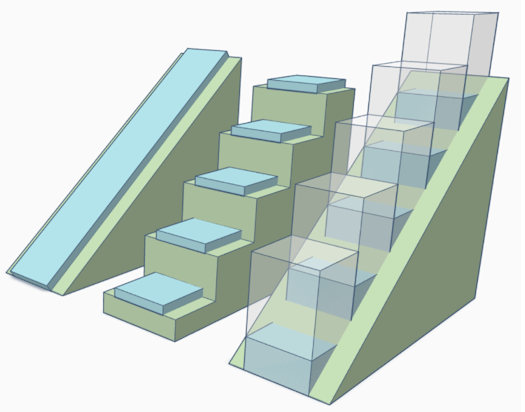
Figure 8 - Terrain representations
